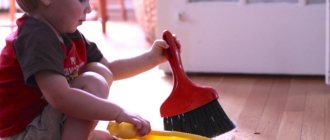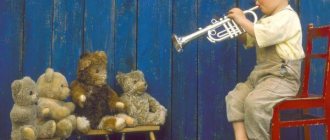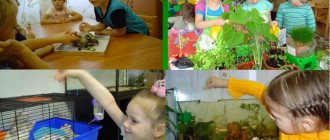Means and methods of aesthetic education in the system of preschool educational organization
Korneva Tatyana Aleksandrovna Migaleva Marina Vladimirovna teachers MBDOU DS No. 72 “Watercolor”
The concept of “aesthetic education” is closely related to the term aesthetics. Aesthetics (from the Greek aisthetiris - sentient, related to sensory perception) is the science of the most general laws of aesthetic, including artistic, human mastery of reality. [4, p.105].
According to scientists, nature is a powerful means of aesthetic education. It is in nature that one can see harmony - the basis of beauty: a variety of colors, shapes, sounds in their combination. Nature itself is a condition for the comprehensive education and development of a child. It becomes a means when an adult purposefully uses its “educational potential” and makes it visible to the child.
The teacher reveals the natural world to children and helps them see it. You just need to see this beauty for yourself and find words that are accessible to the heart of a child. Works of art about nature will provide him with invaluable help in this, which he must know well and skillfully use. In education using the means of nature, it is necessary not only a passive contemplative, but also an effective principle (to protect nature, to help it).
Social life, the work of people with whom the child constantly encounters, is also an important means of aesthetic education. The well-coordinated work of builders makes children want to create a good building, act together, and be attentive to each other. Descriptions of the work of sailors, pilots, teachers, and doctors not only introduce preschoolers to these professions, but also make them want to imitate them. All this is reflected in their games and contributes to the education of moral and aesthetic feelings. [3, p. 157-162]
A multifaceted and inexhaustible means of aesthetic education is art: fine art, music, literature, architecture, theater, cinema. The early introduction of children to real high art contributes to the emergence in the child’s soul of a truly aesthetic perception of reality. Many scientists note that each type of art reflects life in its own way and has its own special impact on the mind and feelings of a child.
Advertising message
Another, no less important, means of aesthetic education is the artistic activity of preschoolers, both organized by the teacher and independent. Fine art is necessary for a child. It gives him rich visual images.
All of the above-mentioned means of aesthetic education - everyday life, nature, art, activity - are effective both on their own and in conjunction, but oversaturation is just as harmful to development as a lack of emotional impact. We must search and find the golden mean.
Having studied the most effective means of aesthetic education in a preschool educational organization, we will move on to studying the methods of aesthetic education.
A method is a way to achieve a goal, a way to solve problems [3, p. 32-39].
Methods of aesthetic education are very diverse. They depend on many conditions: the volume and quality of artistic information, forms of organization and types of activities, and the age of the child. The level of training, skill and abilities of the teacher play a significant role.
A child receives aesthetic information through many channels (social environment, objective world, natural phenomena, works of art). Based on how children receive aesthetic information, methods of aesthetic education can be divided: visual and verbal. Methods also change depending on the forms of organization of activities. During art classes, the teacher gives precise instructions, shows or invites the children to find performance techniques themselves. In practice, methods are used to develop observation skills, independent actions, planning one’s activities and implementing plans. Depending on the age, level of preparedness, growth of individual needs and aspirations of the children, the methods become more complicated.
It should be noted that there are many components that determine the nature of aesthetic education methods. It is difficult to accurately classify them, since they always exist in close connection with others. [5, p. 13-18]
Pedagogical science and practice determine a number of the most effective methods that contribute to the formation of children’s aesthetic feelings, attitudes, judgments, assessments, and practical actions: – the method of persuasion, aimed at developing aesthetic perception, appreciation, and initial manifestations of taste;
- training method, exercises in practical actions designed to transform the environment and develop skills of a culture of behavior;
- method of problem situations that encourage creative and practical actions;
- a method of inducing empathy, emotionally positive responsiveness to the beautiful, and a negative attitude towards the ugly in the world around us [5, p. 87-92].
The peculiarity of the method of persuasion in relation to aesthetic education is that it can be used only when the perceived phenomenon is beautiful. An emotional response occurs in a child when he comes into direct contact with works of art and when he participates in public celebrations. This method can be considered both a visual and verbal method, since any observation of children is accompanied by a simultaneous or subsequent comment from the teacher, awakening the child’s feelings and thoughts.
Systematic exercises in artistic activities and feasible participation in the practice of transforming the immediate environment deepen the activity of children. The method of training and exercise requires repeated repetition. It is used in various conditions. Changing situations helps the child use the acquired skills and strive for further improvement. Repeated exercises in changing conditions allow you to more successfully achieve the desired results. It is important to know that persuasion and training methods do not exist in isolation. Convincing the child of the importance of good deeds, the teacher repeatedly returns to this, as if accustoming children to them.
Thus, the means and methods of aesthetic education we consider in the article in a preschool educational organization help awaken in children a sense of beauty, a desire to act according to their own, childish, but laws of beauty. At the present stage, these means and methods are effective and contribute to the formation of aesthetic feelings, attitudes, judgments, assessments, and practical actions in children.
In general, only a set of methods and means can provide a complete aesthetic education of a child.
Bibliography:
- Barysheva T.A. Empathy and music perception. Interaction of arts in the pedagogical process. – M.: Infra-M, 2000.
- Bolotina L.R. Preschool pedagogy. Textbook / L.R. Bolotina, T.S. Komarova, S.P. Baranova. – Academic project 2005 – 240 p.
- Vendrova T.E., Pisareva I.V. Education with music. – M.: 1991 – 50 p.
- Gogoberidze A.G. Theory and methods of musical education of preschool children. – M.: Publishing House, 2005. – 320 p.
- Kovalitskaya L.M. Methodology for developing skills in visual arts in preschool educational institutions. – Publisher: Arkti, 2008 – 74 p.
Participation – full-time
Section 1. “Methods and techniques for organizing search and research activities of preschool children”
The essence of aesthetic education
Definition 1
Aesthetic education is a specially organized pedagogical process aimed at forming and developing in a child the ability to see, perceive and appreciate beauty in art, nature and everyday life.
Aesthetic education also means the formation of a child’s aesthetic culture and aesthetic taste. At the same time, it is necessary to pay attention to the fact that the process of aesthetic education is connected with other areas of education (labor, political, moral, physical, etc.).
Note 1
The goal of aesthetic education is to reveal in a child the inclinations laid down by nature for the formation of creative abilities to create objects of art according to the canons of beauty.
Are you an expert in this subject area? We invite you to become the author of the Directory Working Conditions
Achieving this goal is possible only if harmony is established between all aspects of the child’s personality, and he is in complete agreement with himself.
Objectives of aesthetic education:
- Systematic and purposeful development in children of the ability to perceive and realize beauty, to experience aesthetic feelings. Children should not only see and feel beauty in its various manifestations, it should evoke in them emotional responsiveness, joy from contemplation, admiration, excitement and passion.
- Introducing children to a variety of activities in the field of art, fostering the habit and need to introduce feasible elements of beauty into the environment, their everyday life and appearance, and also ensure that their behavior complies with generally accepted aesthetic standards.
- Form and develop the ability to evaluate various works of art and life phenomena. Be able to not only evaluate, but express your thoughts and feelings in words, while fully mastering aesthetic terms.
- To develop children's artistic and creative abilities in various fields of activity (music, labor, drawing, modeling, etc.).
Finished works on a similar topic
Course work Aesthetic education as an object of research 410 ₽ Abstract Aesthetic education as an object of research 250 ₽ Test paper Aesthetic education as an object of research 200 ₽
Receive completed work or specialist advice on your educational project Find out the cost
One of the main tasks of aesthetic education is to develop a child’s creative attitude towards the surrounding reality.
In the process of aesthetic education, children develop creative abilities, the ability to think creatively, fantasize, dream, see beauty and experience positive emotions.
Note 2
Thus, the essence of aesthetic education lies in the development of artistic and aesthetic abilities in children, as well as their involvement in creative activities.
Principles of aesthetic education
The system of aesthetic education distinguishes the following principles:
- The principle of the relationship between aesthetic education and art education.
- The principle of complexity. Involves the use of a set of methods and means of working with children in the process of education. When organizing and implementing the educational process, several principles are relied upon simultaneously.
- The principle of unity of the general mental and artistic development of children.
- The principle of applying aesthetics not only within the framework of the educational process, but also in the everyday life of the child (appearance, behavior, filling and maintenance of the children's room, etc.).
- The principle of the relationship between amateur performances and artistic and creative activity in the process of aesthetic education.
- The principle of taking into account the age characteristics, capabilities and needs of each child.
Thus, in order to organize and implement an effective pedagogical process aimed at aesthetic education, it is necessary to rely on these principles and use them when constructing educational work with children.
What does aesthetic education look like in Russian schools?
Basically, the aesthetic education of children is left to teachers of art, music and technology, as well as class teachers who organize cultural trips to performances or exhibitions. Often, teachers do not have enough academic hours to even provide children with the necessary material. Therefore, there is no time left for aesthetic development in the process of studying other disciplines.
“It is impossible to develop aesthetic taste only within the framework of a comprehensive school - there is not enough time for this. There are no separate hours at school for discussing paintings, listening to music and observing nature. If you do this instead of other subjects, it will have a bad effect on mastering the program, and the only thing left is to sometimes go to the theater or museums,” says Anastasia Bondareva, a primary school teacher in the city of Vladimir.
However, this format of extracurricular activities often encounters resistance among schoolchildren, especially teenagers.
“The teachers were always trying to take us to the theater or opera. The first time we left after intermission, and then we refused altogether. Moreover, the performances were interesting, but somehow we liked walking more than being enlightened. And we also tried to skip all extracurricular activities at school: we ran away from class hours, theatrical performances and avoided any ways to educate us - we rarely even went to music and art lessons. I don't blame the teachers because they did everything necessary, but sometimes the kids just aren't interested in it at all. And even threats of bad grades or calling their parents to school cannot force them,” says Evgeniy, a graduate of the St. Petersburg school.
But if a school does not engage in aesthetic education for show, then the students feel it, and then the classes bear fruit.
“Our school constantly held extracurricular activities. We had “rainbow weeks” where we studied different colors and where they are found in nature, trips to the theater together (sometimes the actors even came to school), “social circles” where we sang songs and had heart-to-heart conversations. According to statistics, I can say that 38 percent of graduates entered art universities, and all the guys really loved going to museums. The main thing is to show that it is beautiful and not boring,” recalls Marina, a graduate of a Chelyabinsk school.







